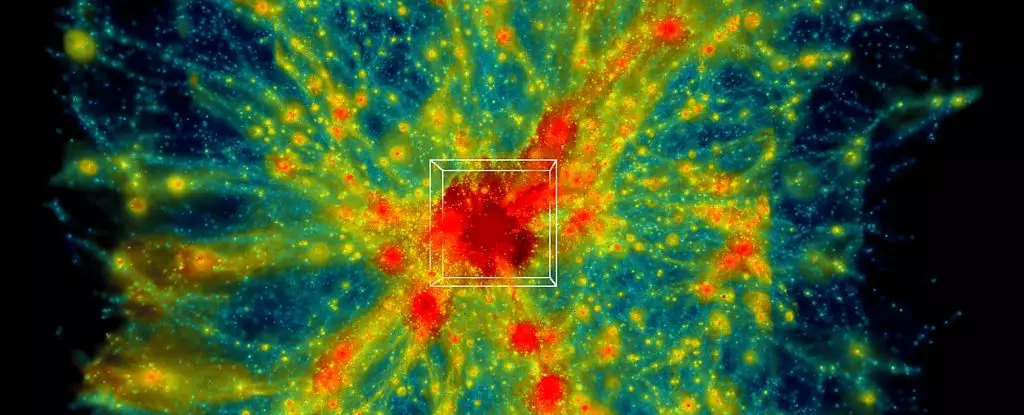Astrophysics stands at the forefront of scientific inquiry, continuously pushing the boundaries of our knowledge about the cosmos. Recently, a monumental achievement at the Oak Ridge National Laboratory in the United States has ushered in a new era of simulations that can potentially transform our understanding of the Universe. This article delves into the details surrounding the ExaSky simulation, the implications of its results, and its significance in deciphering the mysteries of dark matter and cosmic evolution.
In November 2024, researchers were able to utilize the Frontier supercomputer to execute the largest astrophysical simulation recorded to date. Employing over 9,000 computing nodes, this massive operation simulated a region of the Universe that spans more than 31 billion cubic megaparsecs. Such an endeavor is unprecedented and characterized by the intricate intricacies of not only simulating gravitational dynamics but also various forms of matter, both conventional and dark.
The challenge of modeling such an expansive universe comes with significant computational difficulties. Physicist Salman Habib played a crucial role in this extensive project, emphasizing the duality of dark and conventional matter. Dark matter remains elusive, only detectable through its gravitational effects, while normal matter constitutes everything we experience in our daily lives. To accurately depict how these components interact over vast expanses and long periods, researchers require comprehensive simulations that capture the multifaceted nature of cosmic events.
Looking at deep space is akin to looking back in time, as the vast distances light must travel before it reaches us allows researchers to observe the Universe’s history. The evolution of the cosmos occurs over billions of years, thus necessitating sophisticated simulations to fill in the gaps that direct observation leaves. Through computational models, scientists can manipulate time, alter perspectives, and test various cosmic scenarios, thereby playing a god-like role in the exploration of cosmic phenomena.
However, there is a caveat. The simulations require the inclusion of complex mathematical frameworks and cutting-edge computational power. The astounding magnitude of this specific simulation showcases how advancements in technology and algorithmic refinement have made it possible to include many of the variables previously overlooked in earlier models. The struggle to balance accuracy with computational efficiency remains a critical challenge as astrophysicists work towards creating more complete cosmic portraits.
The Evolution of Simulation Technology
The journey to this point has been long and arduous, marked by years of refining algorithms and math that form the backbone of cosmological simulations. The Hardware/Hybrid Accelerated Cosmology Code played an instrumental role in the success of the ExaSky project and demonstrates ongoing innovations in supercomputing that make such ambitious simulations feasible. As computing systems evolve, so too does our capacity to model increasingly significant volumes of the Universe with greater precision.
One of the most promising aspects of the ExaSky project is its commitment to making direct comparisons with contemporary astronomical surveys, like those conducted by the Rubin Observatory in Chile. This kind of comparative analysis is valuable as it allows researchers to validate their simulation results against observable phenomena, enhancing our knowledge of cosmic structures and their formation.
A Glimpse into the Future
Though this initial simulation encompasses only a small fraction—0.001 percent—of the Universe’s total volume, the insights gleaned are poised to generate profound implications for the field of astrophysics. The anticipated outcomes promise to be transformative not only for our understanding of cosmic evolution but also for fundamental questions surrounding the behavior of dark matter and its role within the broader structure of the Universe.
Researchers and astrophysicists are eagerly awaiting to see what revelations lie within the extensive data generated by ExaSky. As we stand on the brink of new discoveries, the intersection of supercomputing, advanced algorithms, and cosmological research offers exciting prospects for the future of our understanding of the cosmos.
The groundbreaking ExaSky simulation signifies a remarkable leap forward in the realm of astrophysics, promising insights that could reframe our understanding of the Universe. By tackling complex gravitational interactions and hydrodynamics, researchers aim to unlock the fundamental secrets that govern cosmic expansion and the elusive nature of dark matter. As technology continues to advance, the cosmos invites us to venture deeper into the mysteries that surround us.

Leave a Reply